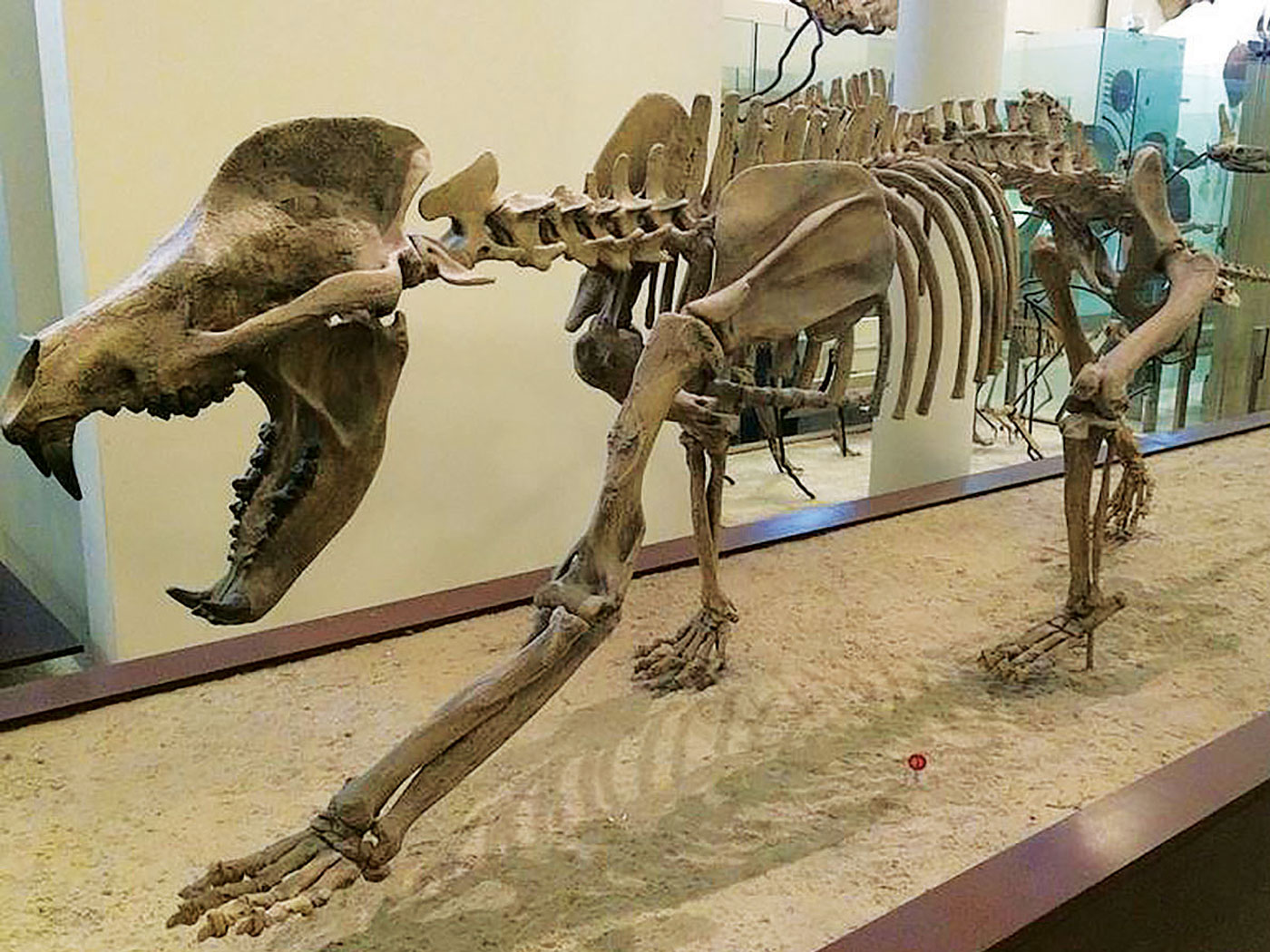Search Tools..
Search Results
« Prev Page Displaying 1 - 10 Next Page »
Radioactive Decay Rates Not Stable - Article
/article/radioactive-decay-rates-not-stable
Brian Thomas, Ph.D. - ... about a century, radioactive decay rates have been heralded as steady and stable processes that can be reliably used to help measure how old rocks are. They helped underpin belief in vast ages and had largely gone unchallenged. But certain decay...
/article/radioactive-decay-rates-not-stable
Brian Thomas, Ph.D. - ... about a century, radioactive decay rates have been heralded as steady and stable processes that can be reliably used to help measure how old rocks are. They helped underpin belief in vast ages and had largely gone unchallenged. But certain decay...
The Age of the Earth's Atmosphere Estimated by its Helium Content - Article
/article/age-earth-atmosphere-helium
Larry Vardiman, Ph.D. - ... the earth is billions of years old, the radioactive production of helium in the earth’s crust should have added a large quantity of helium to its atmosphere. Current diffusion models all indicate that helium escapes to...
/article/age-earth-atmosphere-helium
Larry Vardiman, Ph.D. - ... the earth is billions of years old, the radioactive production of helium in the earth’s crust should have added a large quantity of helium to its atmosphere. Current diffusion models all indicate that helium escapes to...
The Sun Alters Radioactive Decay Rates - Article
/article/sun-alters-radioactive-decay-rates
Brian Thomas, Ph.D. - ... scientists rely on the assumption that radioactive elements decay at constant, undisturbed rates and therefore can be used as reliable clocks to measure the ages of rocks and artifacts. Most estimates of the age of the earth are founded on this...
/article/sun-alters-radioactive-decay-rates
Brian Thomas, Ph.D. - ... scientists rely on the assumption that radioactive elements decay at constant, undisturbed rates and therefore can be used as reliable clocks to measure the ages of rocks and artifacts. Most estimates of the age of the earth are founded on this...
Revisiting the Isochron Age Model, Part 1 - Article
/article/revisiting-isochron-age-model-part-1
Vernon R. Cupps, Ph.D. - ... dating is based on the decay rate of a starting radioactive isotope (the parent) into its stable counterpart (the daughter). An age is assigned to an object by measuring the quantity of each isotope and calculating how long it would...
/article/revisiting-isochron-age-model-part-1
Vernon R. Cupps, Ph.D. - ... dating is based on the decay rate of a starting radioactive isotope (the parent) into its stable counterpart (the daughter). An age is assigned to an object by measuring the quantity of each isotope and calculating how long it would...
Fluctuations Show Radioisotope Decay Is Unreliable - Article
/article/fluctuations-show-radioisotope-decay
Brian Thomas, Ph.D. - ... isotopes are commonly portrayed as providing rock-solid evidence that the earth is billions of years old. Since such isotopes are thought to decay at consistent rates over time, the assumption is that simple measurements can lead to...
/article/fluctuations-show-radioisotope-decay
Brian Thomas, Ph.D. - ... isotopes are commonly portrayed as providing rock-solid evidence that the earth is billions of years old. Since such isotopes are thought to decay at consistent rates over time, the assumption is that simple measurements can lead to...
Creation Scientist Answers His Critics - Article
/article/creation-scientist-answers-his-critics
- ... his recent and foundational research regarding microscopic radioactive crystals called zircons. In a 50-page Internet post, anti-creationist and part-time teacher Kevin Henke criticizes Dr. Humphreys’ work, finding only two mistakes...
/article/creation-scientist-answers-his-critics
- ... his recent and foundational research regarding microscopic radioactive crystals called zircons. In a 50-page Internet post, anti-creationist and part-time teacher Kevin Henke criticizes Dr. Humphreys’ work, finding only two mistakes...
Origins Breakthrough of 2009: Geology - Article
/article/origins-breakthrough-2009-geology
Brian Thomas, Ph.D. - ... level, had dramatically accelerated the decay rate of a radioactive element.4 The sun also altered the rate of radioactive decay in several measured nuclear systems. These findings ought to cause scientists to consider that radioactive decay...
/article/origins-breakthrough-2009-geology
Brian Thomas, Ph.D. - ... level, had dramatically accelerated the decay rate of a radioactive element.4 The sun also altered the rate of radioactive decay in several measured nuclear systems. These findings ought to cause scientists to consider that radioactive decay...
Investigating Polonium Radiohalo Occurrences - Article
/article/investigating-polonium-radiohalo-occurrences
John D. Morris, Ph.D. - Society, 2000), ch. 8, in press. 2 R. V. Gentry, "Radioactive Halos: Implications for Creation," in Proceedings of the First International Conference on Creationism, v. 2, R. E. Walsh, C. L. Brooks and R. S. Crowell, eds.,...
/article/investigating-polonium-radiohalo-occurrences
John D. Morris, Ph.D. - Society, 2000), ch. 8, in press. 2 R. V. Gentry, "Radioactive Halos: Implications for Creation," in Proceedings of the First International Conference on Creationism, v. 2, R. E. Walsh, C. L. Brooks and R. S. Crowell, eds.,...
RATE Summary - Article
/article/rate-summary
Donald B. DeYoung, Ph.D. - ... fission tracks are distinct crystal defects resulting from radioactive decay within crystalline rocks. The RATE team analyzed these radioactive markers in hundreds of rock samples from worldwide locations, which is likely the most extensive such...
/article/rate-summary
Donald B. DeYoung, Ph.D. - ... fission tracks are distinct crystal defects resulting from radioactive decay within crystalline rocks. The RATE team analyzed these radioactive markers in hundreds of rock samples from worldwide locations, which is likely the most extensive such...
Excessively Old "Ages" For Grand Canyon Lava Flows - Article
/article/excessively-old-ages-for-grand-canyon-lava-flows
Steven A. Austin, Ph.D. - ... millions of years with Grand Canyon strata been verified? Do radioactive isotope dating methods provide convincing evidence for billion-year-old rocks? During the last four years, the Institute for Creation Research has undertaken a research...
« Prev Page Displaying 1 - 10 Next Page » /article/excessively-old-ages-for-grand-canyon-lava-flows
Steven A. Austin, Ph.D. - ... millions of years with Grand Canyon strata been verified? Do radioactive isotope dating methods provide convincing evidence for billion-year-old rocks? During the last four years, the Institute for Creation Research has undertaken a research...











